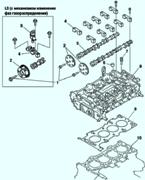Consumers are connected to the "positive" power source by a wire, and to the "negative" one - through the car body ("mass"). This method allows you to reduce the number of wires and simplify installation
The electrical equipment system consists of a battery, a generator, a starter, electricity consumers and electrical circuits
Lighting fixtures include headlights, taillights, fog lights, direction indicators, license plate lights, and interior lights.
The battery is charged by an alternator, which is driven by a belt from the crankshaft pulley.
The starter is a mixed-excitation DC motor with an electromagnetic traction relay.
At start, the traction relay engages the pinion gear with the flywheel ring gear before the starter is powered by the battery.
After the engine starts, the freewheel disengages the starter armature from the flywheel ring gear.
It should be noted that to prevent short circuits and burns, always disconnect the wire from the negative terminal of the battery when working with any element of the vehicle's electrical equipment.
Identification of the source of the problem
The electrical circuit consists of an electrical element, switches, relays, electric motors, fuses, circuit breakers, wires and connectors that connect the current consumer to the battery and body.
To help troubleshoot the electrical system, Vehicle Electrical Diagrams.
Before attempting to determine the source of a malfunction, study the appropriate electrical circuit diagram to get an idea of \u200b\u200bthe elements of this circuit.
The number of possible sources of malfunction can be reduced by checking the operation of other elements included in this circuit.
If several elements or circuits fail at the same time, the fuse common to these circuits or elements may be defective, or the connection to the body - “ground” is broken.
The causes of the malfunction are loose or oxidized connectors, poor contact with the body, blown fuses or faulty relays.
Visually check the condition of all fuses, wires and connectors in the failed circuit before proceeding to check the rest of the elements.
Use the wiring diagrams to determine the end clamps that need to be checked to determine the source of the problem.
The main instruments needed to locate the source of a malfunction are a tester or voltmeter, a 12 V test lamp, an ohmmeter, a battery, and a set of wires with probes, preferably with a circuit breaker or fuse that is used to bypass the wires or elements being tested.
In addition to a broken connection of wires in an electrical system, two more main types of malfunctions are possible - disconnection of the circuit or short circuit.
The circuit opens due to an open circuit, as a result, the current is interrupted, causing the electrical equipment to turn off.
To determine the continuity of the circuit, connect a circuit tester or voltmeter: one lead to the negative terminal of the battery or a grounded element, the other to the contact in the circuit under test, preferably closest to the battery or fuse.
The section of the circuit under test must be powered by the battery, unless the battery connector is not conducting current or the fuse is blown (remember that some electrical equipment circuits turn on only when the key is turned in the ignition switch to a certain position).
Turn on the circuit, then connect the tester probe to the connection closest to the circuit breaker on the side of the element being tested.
If there is voltage (as evidenced by the light of the test lamp or the voltmeter reading), then there are no breaks in the section of the circuit between the corresponding connection and the switch.
If a section is found where there is no voltage, then an open circuit occurred between this point and the point of the previous test, where there was voltage.
An open circuit is caused by a damaged or loose connector.
To detect the source of a short circuit, turn off electrical consumers - lamps, electric motors, heating elements, etc.
Remove the appropriate fuse and connect the tester or voltmeter leads to the fuse contacts.
Turn on the power to the circuit; do not forget that some electrical circuits are switched on only when the key in the ignition switch is turned to a certain position.
If there is voltage in the circuit (as indicated by the warning lamp or voltmeter readings), which means there is a short circuit in the circuit.
If there is no voltage during the test, and the fuse still blows when the same load is connected, the load element has failed.
The negative terminal of the battery is connected to the "mass" - the body, engine or gearbox.
Insecure or oxidized fastening may cause the element to fail or malfunction.
Be aware that many vehicles use "mass" wires between certain elements such as the engine/transmission and the body, i.e. in places where there is no direct contact between metal elements due to soft rubber mounts or a layer of paint.
To check the reliability of the cell grounding, disconnect the battery and connect one of the ohmmeter leads to a reliably grounded cell.
Connect the other lead to the wire or body connection to be tested.
The resistance indicated by the ohmmeter must be zero, otherwise check the connection as described below.
If the reliability of contact with the ground is in doubt, disassemble the connection, remove dirt and clean the contacts.
When reassembling, tighten the connector retainer by applying a coat of petroleum jelly or silicone grease to prevent corrosion.
A continuity test is performed to make sure that a circuit, its section or element conducts current.
Disconnect the wires from the battery terminals and connect a test light probe with its own power source, such as a continuity tester, to one end of the circuit and the other probe to the other end of the circuit.
If the lamp lights up, it means that the circuit is not interrupted and conducts electricity. Switches can be checked in the same way.











